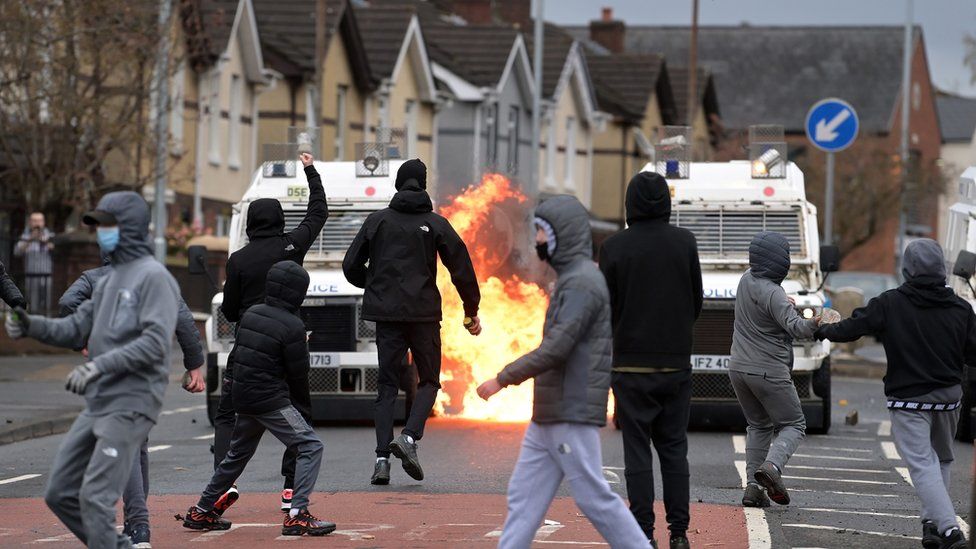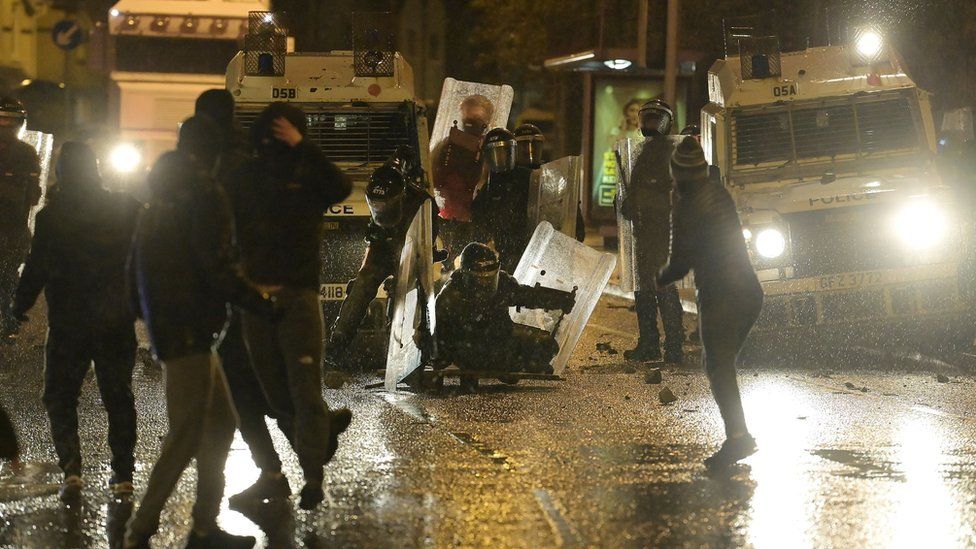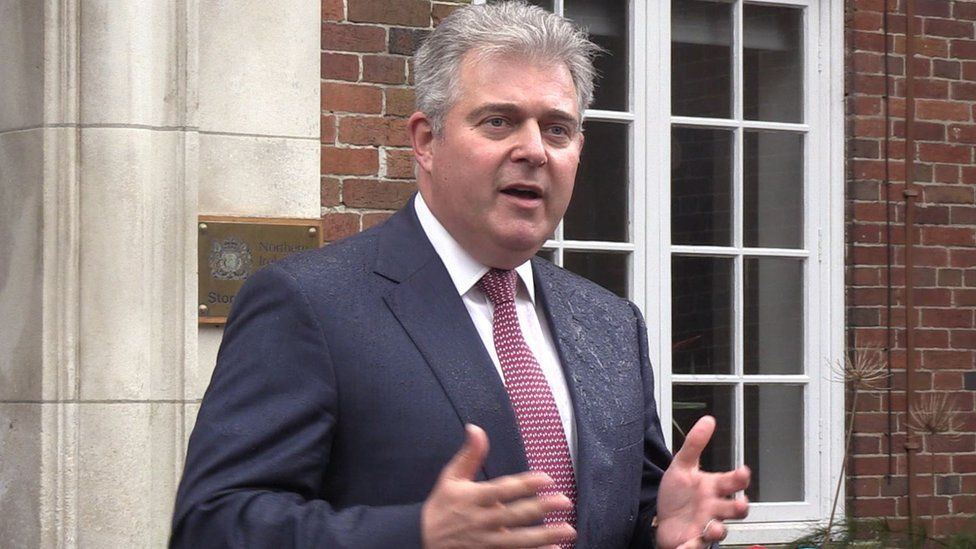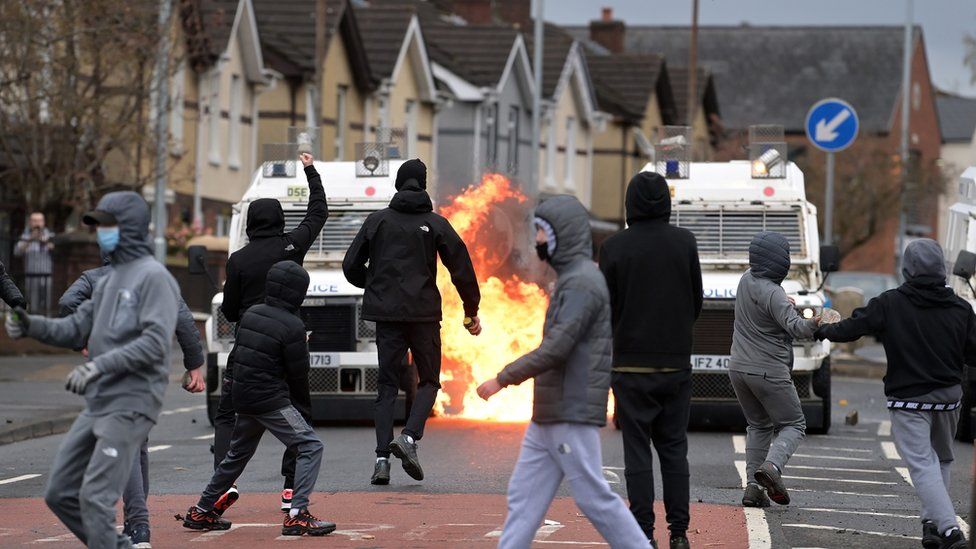BELFAST– Police deployed water cannon for the first time in six years in Northern Ireland after coming under attack in a further night of rioting in Belfast.
Crowds rioted on both sides of gates that separate a loyalist area and a nationalist area in west Belfast on Thursday night.
Petrol bombs, fireworks and stones were again used to attack police, who have faced rising disorder since 29 March.
The Northern Ireland secretary is to meet Stormont leaders in Belfast later.
Brandon Lewis is in Belfast for talks after more than a week of nightly attacks on police in several areas of Northern Ireland.
Kerbs and bollards were ripped up, their remnants turned into weapons.
Police responded by regularly firing their water cannon, but the soaking didn’t seem to stop many of the rioters.
On the nationalist Springfield Road side, police Land Rovers moved up towards the rioters, weaving their way through traffic which was basically stuck in the road for a couple of hours.
Police came under attack too in the Shankill Road area from petrol bombs and stone throwers.
We asked a few people from the community to speak, but they were reluctant.
After midnight the streets were largely clear, but many people are feeling a fresh and familiar sense of worry that there could be renewed potential for more disorder, more disruption and more destruction.

 IMAGE COPYRIGHTCHARLES MCQUILLAN/GETTY IMAGES
IMAGE COPYRIGHTCHARLES MCQUILLAN/GETTY IMAGESThe recent disorder began with petrol bombs and sporadic attacks in a number of mainly loyalist areas, but the unrest spread to a Belfast interface.
Crowds attacked police and each other at the junctions of Lanark Way, off the mainly loyalist Shankill Road, and the mainly nationalist Springfield Road.
The peace wall divides predominantly Protestant loyalists – who are in favour of keeping Northern Ireland as part of the United Kingdom – from predominantly Catholic nationalists who want to see a united Ireland.
A gate that divides the two communities was smashed open and, during several hours of disorder, police officers and a press photographer were attacked and a bus was hijacked and burned.
‘Madness and destruction’
On Thursday night, SDLP councillor Paul Doherty joined a number of political, community and youth representatives on the Springfield Road after crowds of youths gathered in the area.
“We stood at the main interface area creating a barrier almost between these youths and the gate at Lanark Way,” he told Good Morning Ulster.
“They attempted to breach the gate several times, but when it was clear that they weren’t going to gain access to this area they proceeded to attack police further up the Springfield Road.”
He added: “From being on the ground last night and trying to engage with these young people, I’m also noticing that they’re coming from all over Belfast, really, to be involved in these acts of violence.
Sinn Féin councillor Claire Canavan said it was “the actions of the previous night that brought the young people out onto the street on the Springfield Road”.
“I would appeal for calm going forward into the weekend.”
 IMAGE COPYRIGHTCHARLES MCQUILLAN/GETTY IMAGES
IMAGE COPYRIGHTCHARLES MCQUILLAN/GETTY IMAGESBilly Hutchison, a Progressive Unionist Party councillor for the Greater Shankill area, said fewer people were involved in the disturbances on Thursday night, compared to Wednesday.
“I think a lot of things that have been said over the last five or six days have been around for a long time,” he told BBC News NI.
“We need to start thinking about the language we use, we need to start thinking about the information we give out in our communities and we need to support the communities.
“I’m hoping that we’re over it and I’m hoping that people will see sense. It [violence] doesn’t further the unionist cause, it doesn’t further our neighbourhoods.”
Calls for calm
By Thursday morning, police had confirmed 55 officers in total had been injured over the past week.
It is not yet known if any were injured in Thursday night’s violence, which saw police escalate their response with the deployment of water cannon in a bid to disperse rioters.
Prime Minister Boris Johnson and Irish Taoiseach Micheál Martin have spoken over the phone and called for a calming of tensions.
The US has also appealed for calm, with the White House saying it was concerned by the violence.
 IMAGE COPYRIGHTREBECCA BLACK/PA WIRE
IMAGE COPYRIGHTREBECCA BLACK/PA WIREIt is understood the Police Service of Northern Ireland’s Chief Constable Simon Byrne will also be on the call with Mr Lewis and political leaders on Friday.
He will provide an assessment of the latest attacks on his officers.
‘Brexit not an excuse’
When the disorder began last week in loyalist areas of the Northern Ireland it was linked to a decision not to prosecute Sinn Féin leaders for breaching Covid regulations at a funeral last June and tensions over the Irish Sea border imposed as a result of the UK-EU Brexit deal.
The violence in Carrickfergus and Newtownabbey over the Easter weekend was linked to police operations targeting the South East Antrim UDA, a paramilitary group involved in organised crime.
Mr Lewis, who travelled to Belfast on Thursday, has denied that the UK government has abandoned unionists through the new Brexit arrangements.
Ireland’s Foreign Affairs Minister, Simon Coveney, said Dublin and Westminster will support Stormont parties in stabilising the unrest.
‘Utterly reckless’
In a tweet on Thursday night, Justice Minister Naomi Long said it was “utterly reckless and depressing to see more violence at interface areas tonight”.
“My heart goes out to those living in the area who are living with this fear and disturbance.”
SOURCE: BBC NEWS

